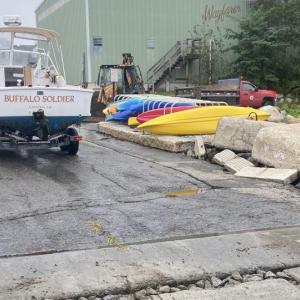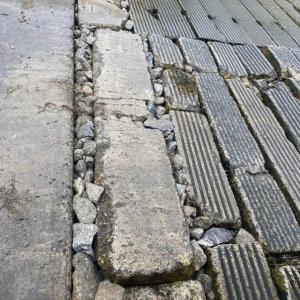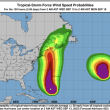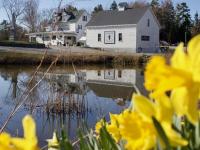Hurricane Lee: Boats and docks get pulled, Central Maine Power leery of tree stress
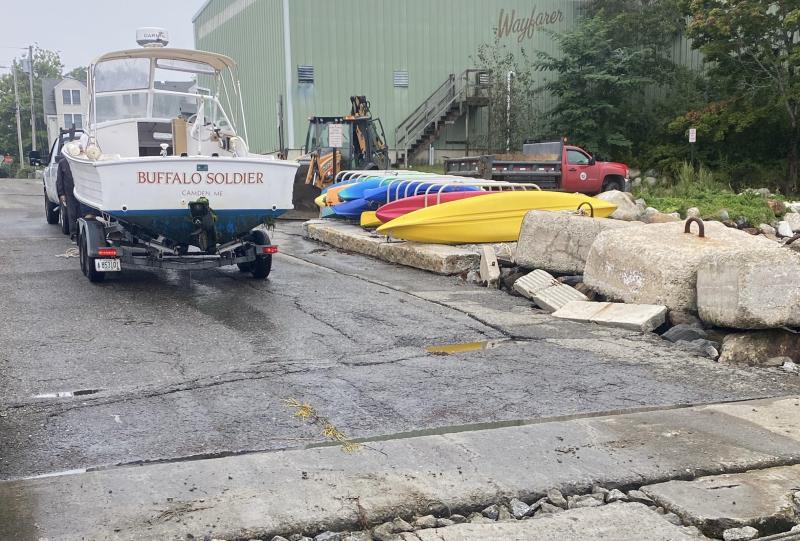 To be on the safe side, John Hanson, of Camden, hauled Buffalo Soldier Sept. 12 at Steamboat Landing, in Camden, in advance of Hurricane Lee. (Photo courtesy Camden Harbor Master)
To be on the safe side, John Hanson, of Camden, hauled Buffalo Soldier Sept. 12 at Steamboat Landing, in Camden, in advance of Hurricane Lee. (Photo courtesy Camden Harbor Master)
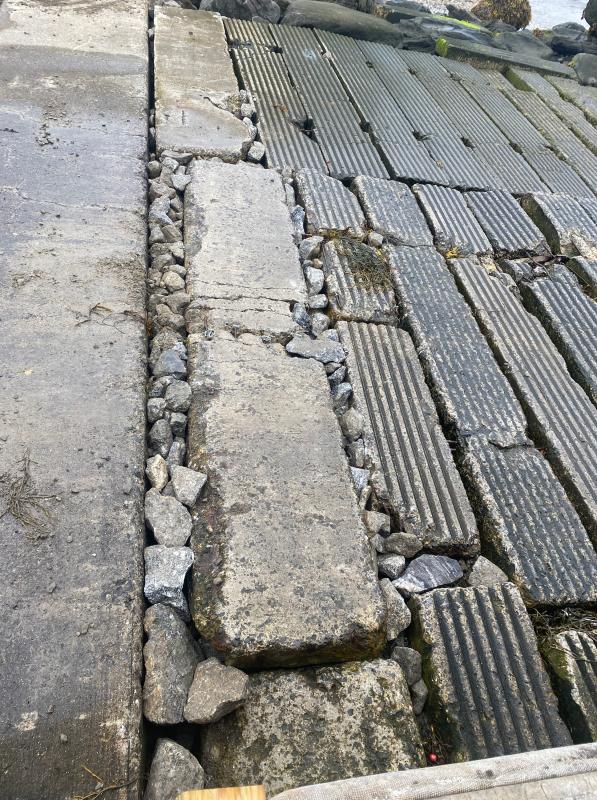 Camden’s Harbor Master and Public Works Department made a quick patch to the aging public launch ramp before the arrival of Hurricane Lee, and in preparation of the high number of boats anticipated to be hauled out of the water. (Photo courtesy Camden Harbor Master)
Camden’s Harbor Master and Public Works Department made a quick patch to the aging public launch ramp before the arrival of Hurricane Lee, and in preparation of the high number of boats anticipated to be hauled out of the water. (Photo courtesy Camden Harbor Master)

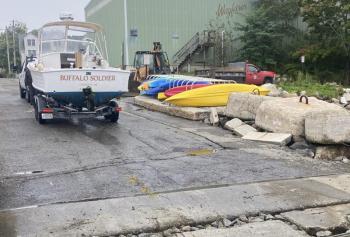 To be on the safe side, John Hanson, of Camden, hauled Buffalo Soldier Sept. 12 at Steamboat Landing, in Camden, in advance of Hurricane Lee. (Photo courtesy Camden Harbor Master)
To be on the safe side, John Hanson, of Camden, hauled Buffalo Soldier Sept. 12 at Steamboat Landing, in Camden, in advance of Hurricane Lee. (Photo courtesy Camden Harbor Master)
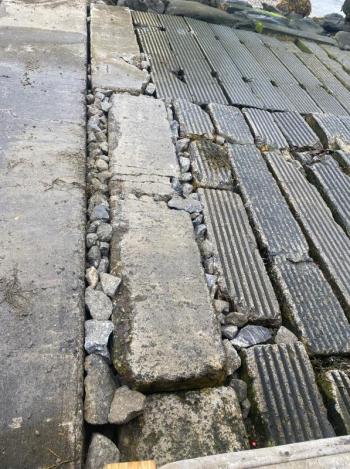 Camden’s Harbor Master and Public Works Department made a quick patch to the aging public launch ramp before the arrival of Hurricane Lee, and in preparation of the high number of boats anticipated to be hauled out of the water. (Photo courtesy Camden Harbor Master)
Camden’s Harbor Master and Public Works Department made a quick patch to the aging public launch ramp before the arrival of Hurricane Lee, and in preparation of the high number of boats anticipated to be hauled out of the water. (Photo courtesy Camden Harbor Master)
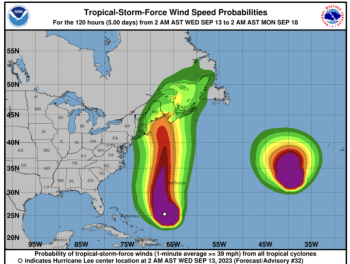
UPDATE: From the Rockport Harbor Master, given Hurricane Lee’s course shift:
“Hurricane Lee has made a shift to the west. While the direction of the winds (northeast/east) is beneficial for Rockport Harbor we will see more wind and rain and sea than initially thought. I am asking that everyone haul ther boats if possible. If not, make sure that all canvas is off the boat, your batteries are charged and inspect chafe gear on your mooring- a secondary pennant is not a bad idea.
“I am asking that all dinghies be pulled out of the water by Friday at 10 a.m. If your plan is to put the boat right back in the water you may leave it on the lawn at the harbor (upside down and secured),
“Please be proactive and safe and reach out with any needs or concerns.”
The path of Hurricane Lee has been under scrutiny for a week, and conversations along Penobscot Bay waterfronts offer up a range of opinions: ‘Won’t blow too hard, we’ve had worse storms. Yes but the ocean surge may be big. Boats need to come out. But the wind will be out of the north east, and it is the wind out of the south east that is most damaging. But the winds will turn. Are you talking the European Model or the local forecast model? But the rains, combined with the soggy summer, will flood and uproot trees. And the leaves are still on the trees, so limbs and branches will come down. The docks should come out and the boats out to be pulled so they do not destroy into each other. But it is only supposed to gust 50, maybe to 60. It will be only a Category 1. Yes, but....”
In other words, like any major storm, there is little definitive about Hurricane Lee’s ultimate intensity and final path through the region. And preparation is key.
Camden Harbor Master Steve Pixley is advising boat owners to haul if they can. He plans to pull the docks in the inner harbor. On Sept. 12, boat owners were already hauling boats.
In Rockport, the harbor is full of sailboats and pleasure boats, but the hauling has picked up. Seas were calm on Thursday morning, and one seasoned sailing couple was heading out in their Alden, taking it across the bay to nestle it into a protected cove.
Lobstermen were talking about their engines. If the wind was out of the north, the sterns would be exposed to the south winds, and swells might overwhelm their mechanical, depending if they have a wet exhaust or a dry exhaust.
Central Maine Power said Sept. 13 that it was, “closely monitoring Hurricane Lee,” and, “Since last week, experts have been carefully evaluating storm’s track while noting that tree health is raising concerns.”
“CMP’s meteorologists are continuously updating our teams with the latest information on Hurricane Lee so we can appropriately prepare,” said CMP spokesperson, Jon Breed. “While forecast models continue to present different storm outcomes, as the track becomes clearer over the next 24-36 hours, we will provide regular updates to our customers on our storm response planning and preparations.
“Maine has had an extraordinarily wet summer, which has resulted in tree stress due to increased soil saturation, flooding, and nutrient runoff. These conditions, which can lead to weakened or rotted root systems, has negatively affected the health of trees across Maine. Some trees began changing color and losing leaves as early as August.
“This summer, the number one cause of power outages has been from stressed trees located outside CMP’s legal ‘right-of-way’ zone that either fall or lose limbs during storms,” said Katie Manende, who leads CMP’s vegetation management program. “Depending on Hurricane Lee’s track and the strength of the storm’s winds, we could see worsened impacts to Maine’s power grid because of these conditions.
“Maine has the highest tree density of any state in the country, along with incredibly stringent tree laws. As a regulated business, Central Maine Power cannot remove trees or exceed the allowed ‘right-of-way’ trimming if a tree is on a customer’s private property, and the company must consult landowners prior to any significant modification to a shade tree, in accordance with the Maine Shade Tree Law.”
Central Maine Power maintains a MPUC approved trim zone, which is defined as 8 feet of side clearance, 15 feet overhead, and 10 feet from the lowest electrical conductor.

